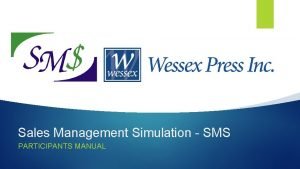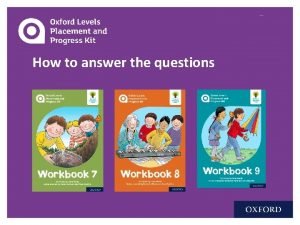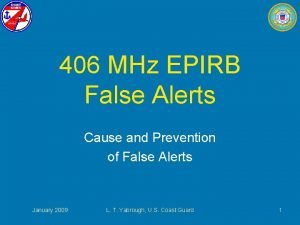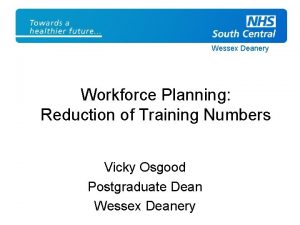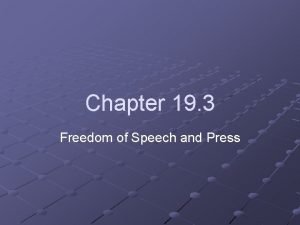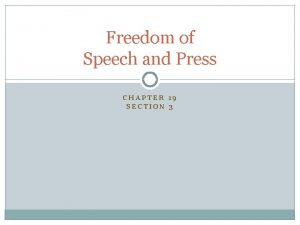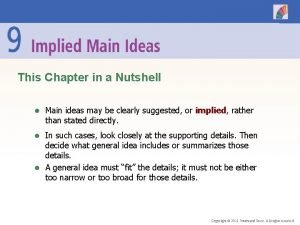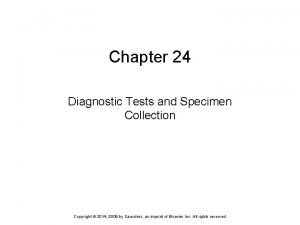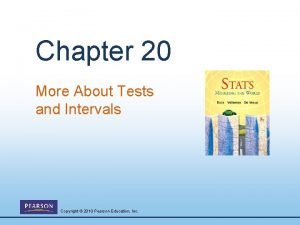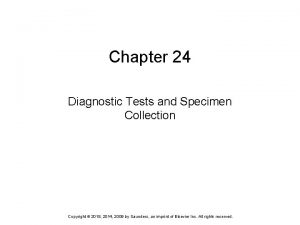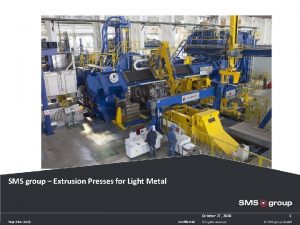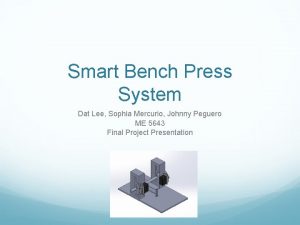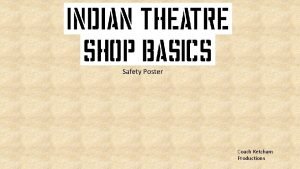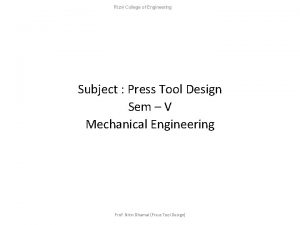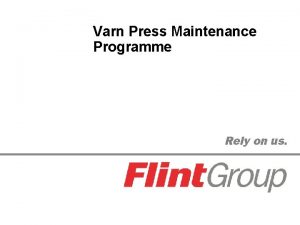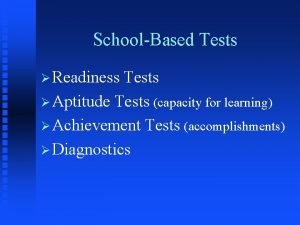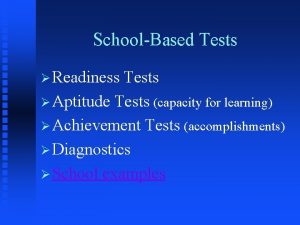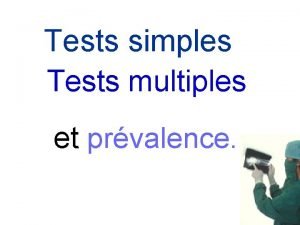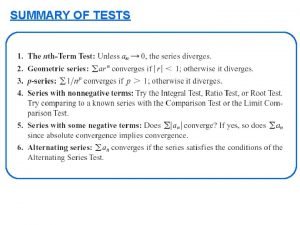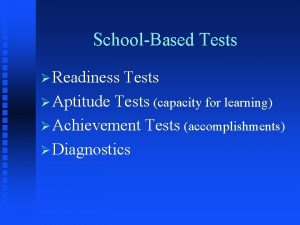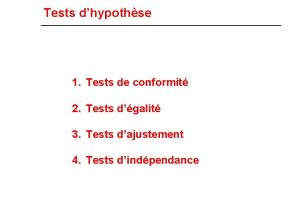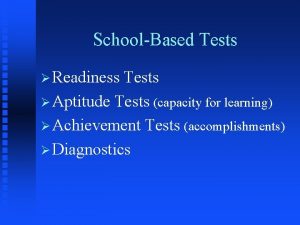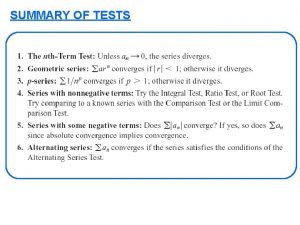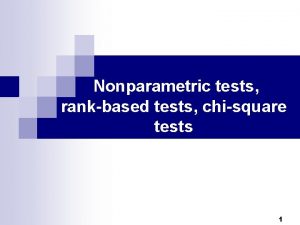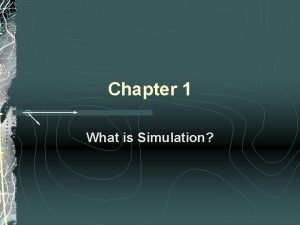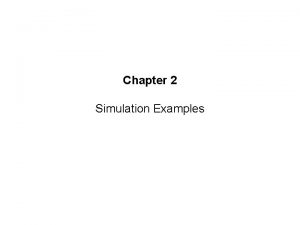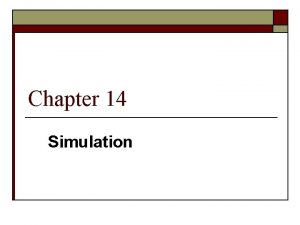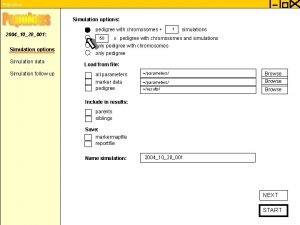CHAPTER 13 Simulation Tests 2019 Wessex Press Human






























- Slides: 30


CHAPTER 13 Simulation Tests © 2019 Wessex Press • Human Resource Selection 9 e • Gatewood, Feild, Barrick

Learning Objectives 1. Understand what a simulation test is. 2. Know the advantages of using a simulation test in selection. 3. Know the limitations of using a simulation test in selection. 4. Understand what a work sample test is. 5. Understand what an assessment center is. 6. Understand what a situational judgment test is. © 2019 Wessex Press • Human Resource Selection 9 e • Gatewood, Feild, Barrick 3

Simulation Tests • Selection devices that assess applicants by means of testing situations that resemble actual parts of the job being considered – the terms performance test and work samples also frequently used • Examples of simulation tests are requiring applicants to § write a simple computer program to solve a common work problem § fix a plumbing leak in a house § work together to design a marketing strategy for a new product © 2019 Wessex Press • Human Resource Selection 9 e • Gatewood, Feild, Barrick 4

Consistency of Behavior • Wernimont and Campbell stated that selection decisions are most accurate when “behavioral consistency” is the major characteristic of the selection program • To clarify their point they categorized all selection devices as either signs or samples § Signs – selection tests used as secondary indicators of an individual’s behavior in job activities – Examples: application forms that ask for degrees, former job titles, years of work experience § Samples – selection tests that gather information about behaviors consistent with the job behaviors being predicted – Examples: instruments that gather information about work experience and educational history related to specific job behaviors, simulation exercises requiring applicants to complete a set of actions that replicate job behaviors © 2019 Wessex Press • Human Resource Selection 9 e • Gatewood, Feild, Barrick 5

Consistency of Behavior Limitations of Simulations • Difficult to construct simulation tests representative of job activities • Simulation tests usually developed on the assumption that the applicants already have the knowledge, ability, skill to complete the job behavior required in the test, if specialized knowledge required, training in that specialized knowledge should be included before the test begins – makes the test longer and more difficult to administer • Simulations much more expensive than other selection devices © 2019 Wessex Press • Human Resource Selection 9 e • Gatewood, Feild, Barrick 6

Consistency of Behavior Types of Simulation Tests • By content of the test: § Motor – simulation that replicates physical activities of the job (e. g. , operating a machine, installing a piece of equipment) § Verbal – simulation that replicates the verbal, cognitive, or peopleinteraction activities of the job (e. g. , simulating an interrogation, demonstrating how to train subordinates) • Fidelity: § Refers to the degree to which the simulation matches or replicates the physical and/or psychological demands and activities of the job for which it is designed © 2019 Wessex Press • Human Resource Selection 9 e • Gatewood, Feild, Barrick 7

Work Samples • The oldest type of simulation used in the early 1900 s to select clerical staff (tests of typing and editing a business letter and skilled tradespeople (automobile repair, carpenters, masons) • Samples of job tasks that applicants are asked to perform – performance is scored • High-fidelity simulations – either motor or verbal • Table 13. 1 presents examples of various work-sample tests and the jobs for which they have been used – a wide variety of tests have been used, even for the same job © 2019 Wessex Press • Human Resource Selection 9 e • Gatewood, Feild, Barrick 8

Work Samples © 2019 Wessex Press • Human Resource Selection 9 e • Gatewood, Feild, Barrick 9

Work Samples The Development of Work-Sample Tests • Steps taken to develop these tests: 1. Perform job analysis 2. Identify important job tasks to be tested 3. Develop testing procedures: • Select tasks • Specify testing procedures • Establish independent test sections • Eliminate contaminating factors • Select the number of test problems 4. Develop scoring procedures (Table 13. 3) 5. Train judges © 2019 Wessex Press • Human Resource Selection 9 e • Gatewood, Feild, Barrick 10

Work Samples © 2019 Wessex Press • Human Resource Selection 9 e • Gatewood, Feild, Barrick 11

Work Samples The Validity of Work-Sample Tests • Studies that examine the validity of work-sample tests in selection have been consistently positive – many single-sample studies § Authors determined only a small difference in validity when objective (measured outcome of the task) or subjective (supervisor’s judgment) job performance criteria measures were used • Work-sample tests demonstrate much smaller differences between groups of black and white applicants than many written tests – especially cognitive ability tests • Other benefits – no complaints lodged about their appropriateness • Can also serve as a way of displaying the actual job to the applicant © 2019 Wessex Press • Human Resource Selection 9 e • Gatewood, Feild, Barrick 12

Assessment Centers • When simulation tests are used for selection of managers, professionals, executives, they are commonly referred to as assessment centers (ACs) • An AC is a procedure for measuring WRCs in groups of individuals (6 -12 people) using a series of devices, many of which are verbal simulation tests • ACs have been used for both selection and career development – we concentrate on those used for selection • The fidelity of simulations in an AC can vary from high to fairly low depending on the specific makeup of the AC – some designed for a particular job, others general appropriate for a group of jobs, some include traditional tests • Because of this variation we think about ACs as having moderate fidelity © 2019 Wessex Press • Human Resource Selection 9 e • Gatewood, Feild, Barrick 13

Assessment Centers The Beginning of Assessment Centers • The Management Progress Study of AT&T marked the beginning of the use of the AC for industrial organizations § Begun in 1956 to study the career development of men hired for managerial positions § One major focus of the study was to identify the WRCs thought to be related to the successful career progress of managers – one challenge was developing measuring devices – A three-and-a-half day assessment center was devised – Managers brought together in groups of 12 – several ways tried to measure personal characteristics – Data obtained from these measures were related to subsequent movement through managerial levels © 2019 Wessex Press • Human Resource Selection 9 e • Gatewood, Feild, Barrick 14

Assessment Centers What Is Measured and How • Dimensions § Starts with a job analysis to identify clusters of job activities that are important parts of the job of interest § Each cluster should be specific and observable, comprising job tasks that are related in some way § These job clusters (dimensions) are measured by the AC devices – think about dimensions as the WRCs measured in ACs § Table 13. 4 provides brief definitions of nine dimensions commonly used in assessment centers – note that these dimensions are defined based on actual job activities © 2019 Wessex Press • Human Resource Selection 9 e • Gatewood, Feild, Barrick 15

Assessment Centers © 2019 Wessex Press • Human Resource Selection 9 e • Gatewood, Feild, Barrick 16

Assessment Centers What Is Measured and How • Traditional assessment devices § The AT&T ACs often used various types of traditional tests and interviews – mental ability, projective personality, paper-and-pencil personality tests § Because of the expense of using and interpreting such tests, no longer used very often § However ACs do commonly use an in-depth interview that is similar to the background interview – gather information from the candidate about job activities that represent the behavioral dimensions being evaluated § Each interview is structured and focuses on previous job behaviors – formal scoring system used to evaluate each behavioral dimension, shown to be effective at arriving at a final evaluation © 2019 Wessex Press • Human Resource Selection 9 e • Gatewood, Feild, Barrick 17

Assessment Centers What Is Measured and How • Simulation tests § In-Basket – a paper-and-pencil test designed to replicate administrative tasks of the job under consideration (Table 3. 5) § Leaderless group discussion (LGD) – designed to represent those managerial activities requiring interaction of small groups of individuals in order to solve a problem successfully, participants tested in groups of six, no one member designated as the official leader or supervisor of the group (Table 13. 6) § Case analysis – each participant provided with a long description of an organizational problem that changes according to the job being considered, case frequently describes history of certain events in a company with relevant financial data, marketing strategy, organizational structure, case focuses on a dilemma that the participant is asked to resolve (must give specific recommendations, present supporting data, detail any changes in company strategy) © 2019 Wessex Press • Human Resource Selection 9 e • Gatewood, Feild, Barrick 18

Assessment Centers © 2019 Wessex Press • Human Resource Selection 9 e • Gatewood, Feild, Barrick 19

Assessment Centers © 2019 Wessex Press • Human Resource Selection 9 e • Gatewood, Feild, Barrick 20

Assessment Centers The Training of Assessors • If an AC is to be useful as a selection device, it is crucial that assessors (staff members who have the responsibility of observing and evaluating behaviors of participants) have the necessary training (Table 13. 7) • The major duty of an assessor is to record the behavior of a participant in an exercise and use that data to rate the participant on each behavioral dimension appropriate for the exercise • Assessors are usually managers within the organization • After all exercises have been completed, assessors come together to discuss their observations • Ratings and data gathered by each assessor are used to develop group or final scores of each participant on each dimension © 2019 Wessex Press • Human Resource Selection 9 e • Gatewood, Feild, Barrick 21

Assessment Centers © 2019 Wessex Press • Human Resource Selection 9 e • Gatewood, Feild, Barrick 22

Assessment Centers The Training of Assessors • Understanding the behavioral dimensions § The first step in training assessors is to familiarize them with the behavioral dimensions – all assessors should have a common understanding of the dimensions § Example definition that could be used for an AC dimension focused on first-line supervisors: Tolerance for stress: Stability of performance under pressure and/or opposition. A first-line supervisor finds himself/herself in a stressful situation because of three main factors: (a) multiple demands on the work unit that must be completed at approximately the same deadline, (b) the joint roles he/she must play as both a representative of management to nonmanagement employees and a representative of nonmanagement employees to management, and (c) confrontation by employees who are angry or hostile because of a work situation. © 2019 Wessex Press • Human Resource Selection 9 e • Gatewood, Feild, Barrick 23

Assessment Centers The Training of Assessors • Observing the behavior of participants § Initial tendency of assessors is to immediately make evaluative judgments about the performance of participants in AC exercises – instead they should focus on recording the behavior of the participant • Categorizing participant behavior § Assessor must record the behavior of the participant under the proper dimension • Determining the rating of participant behavior § Assessors must be consistent in the use of rating scales to evaluate the behavior of participants on the dimensions © 2019 Wessex Press • Human Resource Selection 9 e • Gatewood, Feild, Barrick 24

Assessment Centers The Training of Assessors • Determining dimension and overall evaluation ratings § Combine the data on the same dimension across two or more exercises – focuses on using PEDRs (post-exercise dimension ratings) to develop DRs (dimension ratings) § Last step in training concerns how to use the DRs to form the OAR (overall assessment rating) of the participant’s ability in the complete AC to determine the most critical dimensions which are weighted more heavily in producing the overall rating § Assessor groups are often required to complete a mock assessment or a small group of candidates under observation of experienced assessors © 2019 Wessex Press • Human Resource Selection 9 e • Gatewood, Feild, Barrick 25

Assessment Centers The Validity of Assessment Centers • Phase 1: We Love Assessment Centers! § Ratings predictive of movement into middle-level management § Reduced or eliminated both racial and gender differences – evidence ACs could produce adverse impact § For about 25 years after AC development at AT&T, selection specialists loved ACs © 2019 Wessex Press • Human Resource Selection 9 e • Gatewood, Feild, Barrick 26

Assessment Centers The Validity of Assessment Centers • Phase 2: This Is Not Working and It’s Your Fault, Not Mine! § 1982 research study focused on the failure of ACs to demonstrate the pattern of correlations among dimension ratings they were predicted to produce § If the dimension of planning and organizing measured with in -basket test, interview, and case analysis, then correlation of ratings for participants should be quite high – referred to as convergent validity – but evidence show that ratings were very low © 2019 Wessex Press • Human Resource Selection 9 e • Gatewood, Feild, Barrick 27

Assessment Centers The Validity of Assessment Centers • Phase 3: Well I Might Have Made a Mistake and We May Be Okay After All. § This phase of thinking and research on ACs started in the early 2000 s § Its major theme is that the measurement model that expected PEDRs to correlate for the same dimension across exercises and not to correlate among different dimensions within an exercise is an incorrect way of thinking about ACs – AC OAR scores found to consistently correlate with various measures of work performance © 2019 Wessex Press • Human Resource Selection 9 e • Gatewood, Feild, Barrick 28

Situational Judgment Tests • Situational judgment tests (SJTs) are verbal simulations and regarded as low-fidelity because they are almost exclusively descriptions of work situations or behaviors rather than actual replications • They ask the respondent to choose among multiple-choice alternatives that are various behaviors that may be taken to address the work situation described in the question • Table 13. 8 contains examples of item stems (questions) and possible responses that may be contained in a situational judgment test © 2019 Wessex Press • Human Resource Selection 9 e • Gatewood, Feild, Barrick 29

Situational Judgment Tests © 2019 Wessex Press • Human Resource Selection 9 e • Gatewood, Feild, Barrick 30
 Wessex sales management simulation
Wessex sales management simulation ıniqlo
ıniqlo Oxford university press 2019 answers
Oxford university press 2019 answers Windsors family tree
Windsors family tree 7 kingdoms of england
7 kingdoms of england Wessex maternity academy
Wessex maternity academy Essex wessex mercia northumbria
Essex wessex mercia northumbria Sussex and wessex
Sussex and wessex Pains wessex epirb battery replacement
Pains wessex epirb battery replacement Anglo saxon england map
Anglo saxon england map Wessex deanery
Wessex deanery Ryan waters neurosurgeon
Ryan waters neurosurgeon Chapter 19 section 3 freedom of speech and press
Chapter 19 section 3 freedom of speech and press Chapter 19 section 3 freedom of speech and press
Chapter 19 section 3 freedom of speech and press Townsend press chapter 4 implied main ideas
Townsend press chapter 4 implied main ideas Chapter 8 human needs and human development
Chapter 8 human needs and human development Chapter 8 human needs and human development
Chapter 8 human needs and human development Chapter 23 specimen collection and diagnostic testing
Chapter 23 specimen collection and diagnostic testing Chapter 20 more about tests and intervals
Chapter 20 more about tests and intervals Chapter 23 specimen collection and diagnostic testing
Chapter 23 specimen collection and diagnostic testing Excel chapter 8 simulation exam
Excel chapter 8 simulation exam World missionary press booklets
World missionary press booklets Wax pattern fabrication
Wax pattern fabrication Thermal press hair
Thermal press hair What is the importance of the penny press? *
What is the importance of the penny press? * Purdue owl subject verb agreement
Purdue owl subject verb agreement Hmt hettstedt
Hmt hettstedt Smart bench press
Smart bench press Drill press safety poster
Drill press safety poster Rundown press conference
Rundown press conference Press tool design
Press tool design
